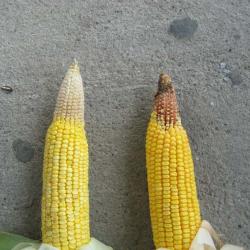Corn Ear Tip Back
It appears corn ears have tipped back more than normal in a large number of fields and seed brands across a wide geography in the corn belt this year. What can we blame this on? Well, the list is long for possible causes of ear tip back from year to year.

Drought, excessive post pollination heat, shortage of nutrients, hail, insects, disease, high planting populations, and genetics are just some of the many things that get blamed for this. Sometimes it’s a combination of more than one and sometimes it’s hard to pinpoint anything at all for why it happens.
I would agree that in some instances loss of nitrogen can be to blame in those fields that were water logged early and often this year. But what about those fields showing excessive tip back that we know are not short of fertilizer, did not get flooded or hailed, have no real disease or insect pressure, experienced no drought, and are not planted at high populations? What about these that look absolutely beautiful and healthy but when you walk in and pull back ears, you see 3 inches of tip back? The answer isn’t always clear cut and may be fairly complex.
One thing is certain. A stress or stresses at the time period following pollination triggered the corn plant to abort some of the kernels at the tip of the ear. Although there has been very little drought stress to our corn crop this year we have to remember drought stress and heat stress are not the same. A corn plant would rather go through its ear fill period at moderate temps than at temps much above 86 degrees. We did have a prolonged period of excessive temperatures during the post pollination period this year. Those nights where temps failed to dip below 70 degrees can be especially detrimental to grain fill and starch accumulation. This may have played a direct roll in some of this excessive ear tip back we are seeing in some fields this year.
I would not try blaming it on any one hybrid either. Yes, you will see some hybrids do it much worse than others at locations but I think it’s more about the way that specific hybrid responded to its environment at that location than the hybrid itself. The above picture shows two ears that I pulled from fields last week over 100 miles apart. The hybrids are both tipped back significantly and they share absolutely no genetic relation. In summary, the corn plant is a complex plant physiologically and reacts to the many different curve balls mother nature throws its way.
As always, keep an open mind when trying to determine why things happen in a corn field. Often times there is no one absolute right or wrong answer.
- Ryan Spurgeon, Hoegemeyer Hybrids
